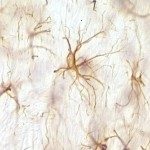Link to Pubmed [PMID] – 8866480
Mol. Microbiol. 1996 Aug;21(3):579-92
Entry of Listeria monocytogenes into cultured epithelial cells requires production of internalin, a protein with features characteristic of some Gram-positive bacterial surface proteins, in particular an LPXTG motif preceding a hydrophobic sequence and a few basic residues at its C-terminal end. By immunofluorescence and immunogold labelling, we show that in wild-type L. monocytogenes, internalin is present on the cell surface and has a polarized distribution similar to that of ActA, another surface protein of L. monocytogenes involved in actin assembly. Through a genetic analysis, we establish that the C-terminal region of internalin is necessary for cell-surface association, and that although internalin is partially released in the culture medium, its location on the bacterial surface is required to promote entry. Finally, using a ‘domain-swapping’ strategy-replacement of the cell wall anchor of IniA by the membrane anchor of ActA- we show that the reduced ability to adhere and enter cells of strains expressing IniA-ActA correlates with a lower amount of surface-exposed internalin. Taken together, these results suggest that internalin exposed on the bacterial surface mediates direct contact between the bacterium and the host cell.



